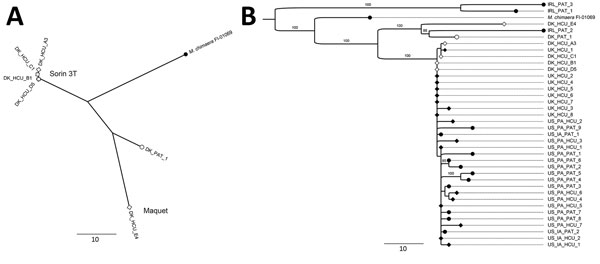Volume 23, Number 3—March 2017
Dispatch
Mycobacterium chimaera in Heater–Cooler Units in Denmark Related to Isolates from the United States and United Kingdom
Figure

Figure. Maximum parsimony phylogenies showing the relationship between Mycobacterium chimaera isolates found in patients (circles) and heater–cooler units (HCUs; diamonds) in Denmark. M. chimaera strain FI-0169 (accession no. PRJNA356276) was included for reference. A) Tree showing isolates from Sorin 3T (Sorin Group, Arvada, CO, USA) and Maquet (Maquet, Wayne, NJ, USA) HCUs and a non–HCU-associated isolate from a patient (PAT) in Denmark (DK). B) Phylogenetic tree comparing isolates from Denmark to 31 isolates collected in 3 other countries (Ireland [IRL], United Kingdom, and United States) and retrieved from the European Nucleotide Archive (http://www.ebi.ac.uk/ena). Isolates from Denmark are indicated by open symbols and isolates from other countries by solid symbols. Branch values indicate percentwise bootstrap support (only >70% support is shown), based on 100 replicates. IA, Iowa; PA, Pennsylvania. Scale bars represent a difference of 10 single-nucleotide polymorphisms.